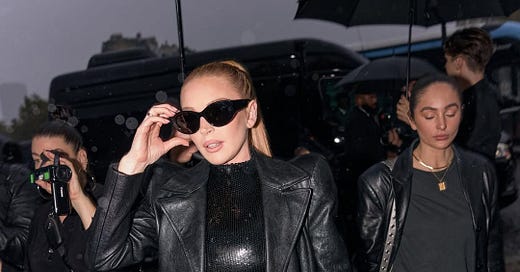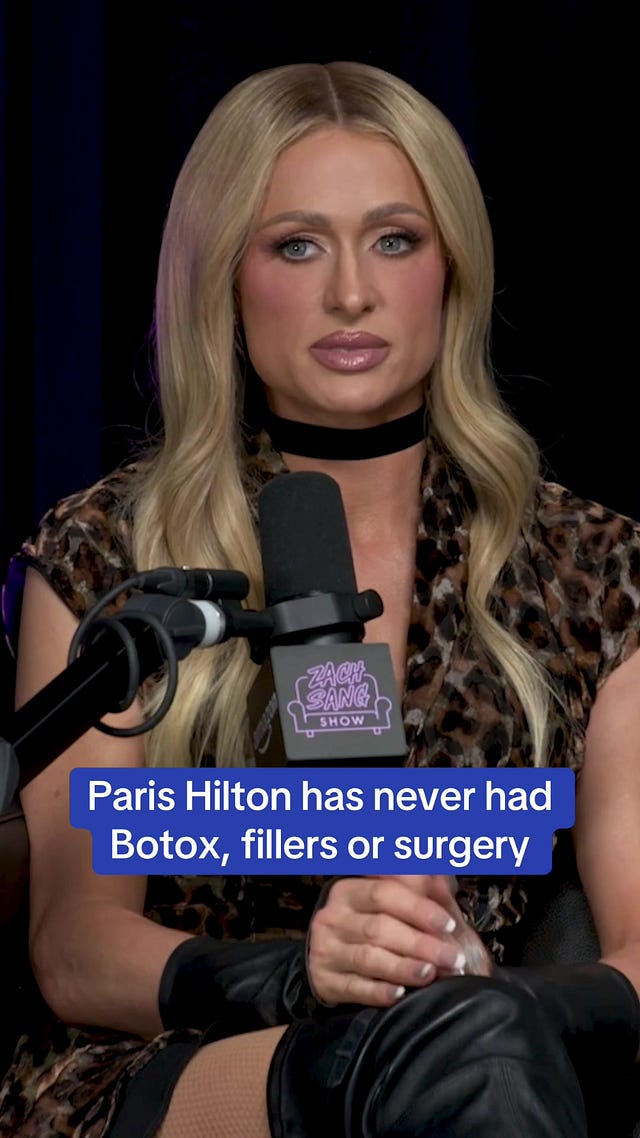This, and whatever Lindsay Lohan had done
While well-deserved, the star's celebrated return to the limelight raises questions
It’s 2024, and Lindsay Lohan’s looks have been called a ‘cultural reset’. A few short years ago, Lohan was a Hollywood outcast, deemed another casualty of child stardom and providing a cautionary tale for other young starlets. She’d become something of a joke, better known for her personal struggles than her incredible talent.
Now after a long hiatus from Hollywood, the star has been making a return to the spotlight with new projects and as of this year, a new face – which looks strikingly similar to her old one. However unlike Lohan’s previous dalliances with apparent surgical intervention, there are no nasty comments. This time, she’s being roundly celebrated for ‘impeccable’ cosmetic work.
As Lohan faced addiction issues, a flailing career and various legal battles, tabloids picked apart her changing looks over the years – including the work she was heavily derided for having done, which was attributed to an overload of facial fillers (the ‘pillow face’ effect). Now she’s returned, and all physical evidence of the last two decades seems to have disappeared – and with curious timing, we’re suddenly ready to embrace and celebrate her again.
Gone are the many things we criticised her for – the extensions (“messy”), bold hair colours (“unflattering”) and fake tan (“trashy”) – superseded by a nostalgic version of Lohan, with a more ‘tasteful’ glow and a return to Lohan’s signature auburn shade. Tabloids that once snickered, ‘What HAS she done to her looks?’ have been placed in the shade of wall-to-wall praise and admiring speculation about her ‘incredible’ transformation.
Spectators are desperate to know what dark magic could conjure Lohan’s ‘lost’ youth with almost no trace of identifiable effort. While Lohan insists it all comes down to skincare, as well as the occasional “Morpheus[8], IPL, and lasers”, cosmetic doctors weighing in on recent images of the star dub it to be the result of “good surgical and non-surgical work”. Notably, Lohan appears to have had her fillers dissolved, which was once the most obvious tell of injectables.
The reason that Lohan’s ‘new look’ really resonates is because it’s actually… her old one. As Lohan’s celebrity began to take its toll in the late Noughties and she appeared to engage in cosmetic work, the public shook its head in disapproval. Now, as her face better resembles that of the young starlet we met in Mean Girls – when her fame was still friendly – we’re suddenly more accepting of her.
As she commenced work on the reboot of 2003’s Freaky Friday with Jamie Lee Curtis this year, surely Lohan predicted that reprising a character that she first played more than twenty years ago would prompt widespread comparison between her Disney days and the woman she is now; a 38-year-old married mother of one. Filming began back in June, Lohan fronted up looking ‘fresher’ than ever, and we all collectively lost our minds.
For a long time, Lohan’s biggest role was as the star of highly-acclaimed memes. Now she has contorted herself back into someone we once knew and loved; a familiar face that’s returned to Paris Fashion Week and perched front row at the Balenciaga show. All ‘nature is healing’, if nature could be authentically be credited with something such as this.
To tweak or not to tweak?
There’s a particular derision that we reserve for women who are perceived to have failed in their quest to attain the ultimate prize of physical attractiveness – at least, as it relates to an entrenched feminine ideal. From the moment their looks begin to change unfavourably, public pity trickles in to chasten these women: “oh it’s such a shame she had work done” and “she WAS so beautiful”.
Was. It’s this kind of backhanded cruelty that often fuels the resolve to drastically alter one’s appearance. Scorned for engaging or shamed for getting older, it feels like approval is impossible either way. Heather Gay, a current cast member on The Real Housewives of Salt Lake City, confronted this complexity in a recent episode of the series, when her Ozempic-assisted weight loss was dubbed a contradiction to her previous assertions of body positivity.
“Losing weight… changed the way that people treated me. And people were nicer to me and that made me feel sad,” she told Entertainment Tonight. In another interview with People, she added, “It's just the way the world works and that makes me sad for women.” The cognitive dissonance required to partake in these practices, even as we knowingly battle internalised misogyny, unearths the inner conflict that many women feel.
Lohan, to her part, is likely no exception but her rapid reascension is proof of this physical bias we continue to carry. So why are we so celebratory of women who engage in extensive cosmetic work when it’s done ‘well’... yet so scornful of those less successful in the pursuit of enduring youth?
Restoration > transformation
To say that a woman ‘looks exactly the same’ as her younger self at the height of her beauty has always been considered a more virtuous achievement than that which has been augmented (or ‘she looks completely unrecognisable’). This new era of surgical strategy is all about reviving and preserving the past self, rather than building a whole new one.
Lohan, along with an apparently immortal Paris Hilton and Christina Aguilera, are currently the poster-children for turning back the clock – but is that because their youthful visage rings somewhat true to the looks they found fame with? Features, however deftly manipulated they may be, are ultimately considered to be “theirs”, rather than a manufactured reflection of unearned beauty (à la the Kardashians).
Why is this, do we think? Is it that we perceive women who use the money and cosmetic expertise at their disposal to advance their aesthetics to be ‘cheats’? Would such a notion also explain why society delights in the times that famous women seem to get it wrong – almost as if it’s a deserving form of justice or indeed a punishment for engaging in such practices?
Suspicions aside, the end results that are deemed acceptable to us seem to be because they’re inherent to the star’s god-given looks. Ageing gracefully no longer comes naturally, as for better or worse, our perception of what constitutes true beauty has evolved. We’re seeing the literal deflation of the Kardashian aesthetic in real time, as The Hollywood Reporter calls it. While the famous family was once known for “bee-stung lips” and “a wasp waist dividing an ample butt and prominent breasts”, such obvious work to glamourise one’s appearance is now considered tawdry.
This time around Lohan’s work is almost seamless, albeit suspiciously so, which makes it worthy of applause and for many, relief. Lohan fans are breathing easier now that she looks so good, as they know that it’s akin to her value in the eyes of a shallow industry; a veritable key for re-entry into Hollywood and the media’s good graces. As long as she can maintain it (and avoid the committing the cardinal sin of overdoing it again) she’ll probably be permitted to stick around.
Owning up to it
This new era of work is harder to decipher – and therefore easier to deny – than ever before. Over the last few years Lohan has no doubt learned from watching the peanut gallery hurl criticism at her contemporaries, whether they’re actually blatant about the work they’ve had done or not. There’s always the very valid question of whether it’s detrimental to discuss women’s looks at all.
Being honest about procedures would arguably be helpful in both removing stigma and social distortion about what’s considered ‘normal’. So far, Lohan won’t confirm. She knows that she can’t entirely deny her new face, but she also carries the inevitable pain of past speculation and derision about her appearance. In her mind, opening up about what exactly she’s had done would probably invite further speculation and unsolicited conjecture from the public about her appearance.
An old party pal of Lohan’s, Paris Hilton, has also received praise for her mysterious ability to “age backwards”. In a viral TikTok clip, Hilton herself says, “I feel really proud that I’m all-natural. I’ve stayed out of the sun, I’ve never done any Botox, injectables, no surgery, nothing… My mom told me when I was 8 years old, ‘Paris, stay out of the sun.’ Then she taught me this amazing 10-step skincare routine. So I’ve literally been doing that since [I was] 8.”
Excuse me for a brief moment, as I allow my eyes to descend from the back of my skull to the screen. Deep breath! Okay, there we go.
Hilton’s comments generated inflammatory headlines and were met with disbelief from a large portion of the public, but the moment ultimately came and went. She wasn’t pitied for falling victim to the pressure, or called a bad influence on young girls. The world might’ve raised its eyebrows, but it swiftly moved on.
That would seem a more desirable outcome for anyone in the public eye, so it’s no surprise that Lohan would follow a similar script. However if the celebrities aren’t talking about it, and the work that’s being done is deliberately undetectable, is it up to us to acknowledge it as an unrealisic representation of most women?
An ageless era
Although plastic surgery rumours remain unconfirmed, Lohan historically isn’t the typical candidate for the kind of drastic anti-ageing procedures she’s suspected of having. Regardless if it’s true or not, I suspect we’ll see much greater interest and uptake within a younger demographic as a direct result of the media’s proliferation of this narrative.
Will we reserve our judgement about their outcomes? Probably not. Should we endeavour to reexamine our treatment of women in relation to their looks – ‘real’, ‘earned’ or otherwise? Always. Whether we like it or not, the ongoing discourse around Lohan’s transformation ultimately sends a singular message: if you’re a woman, society still considers your visible markers of age (or any unsuccessful attempts to disguise them) to be unacceptable.
And let’s be honest, that may well be its own form of coercion at this point.








